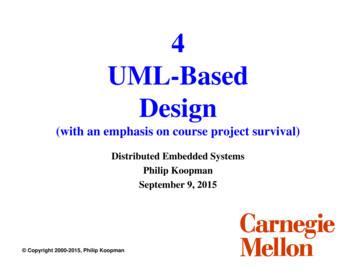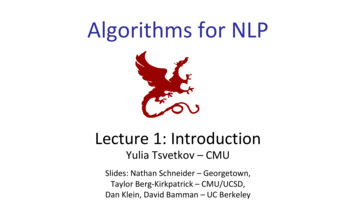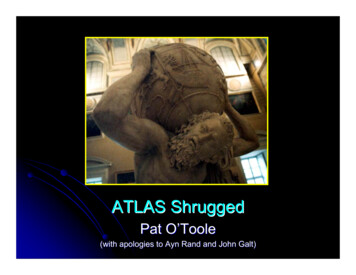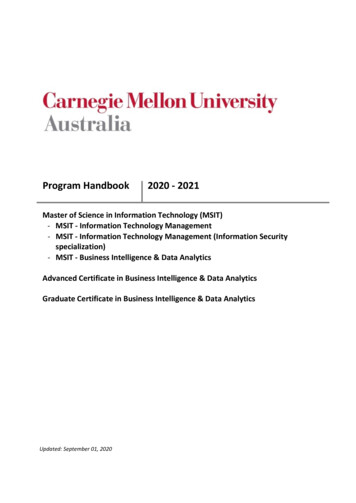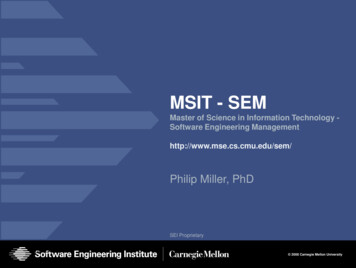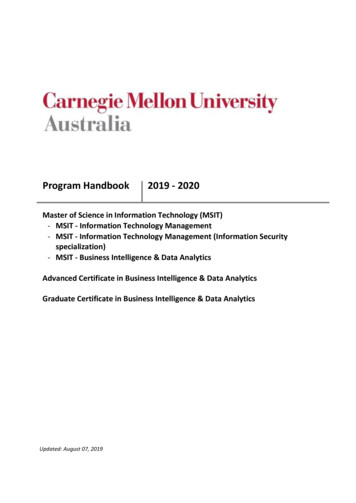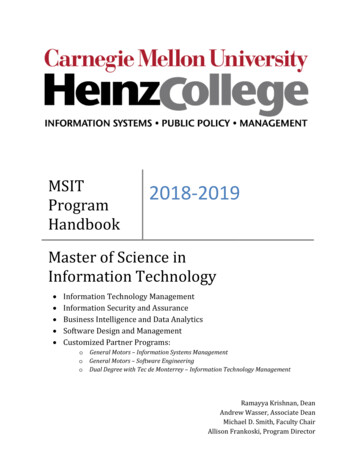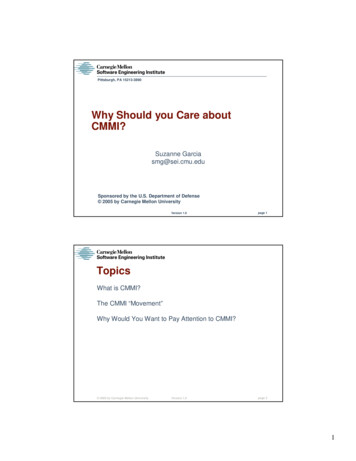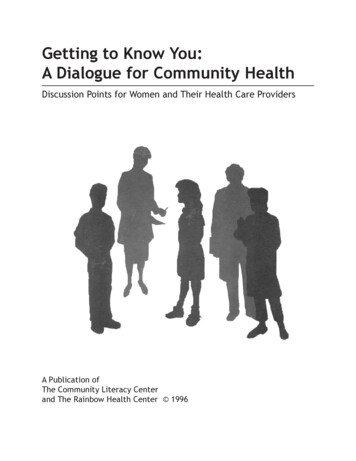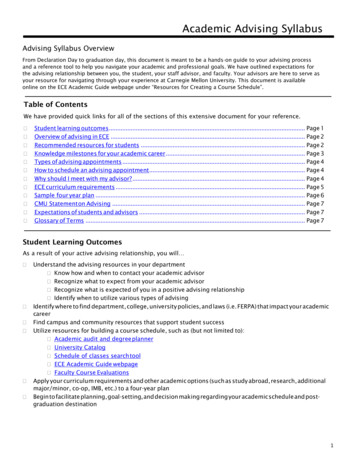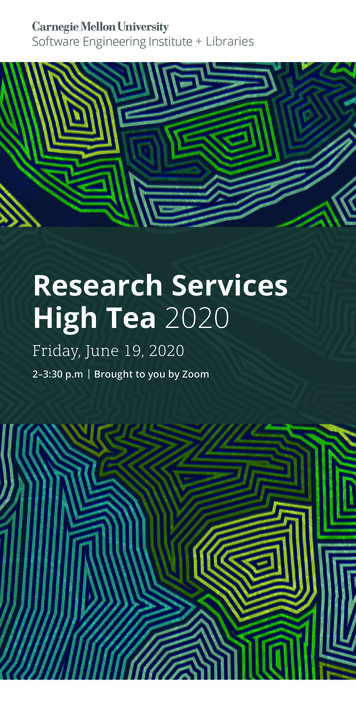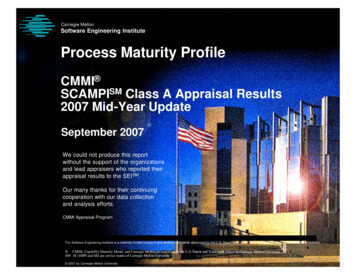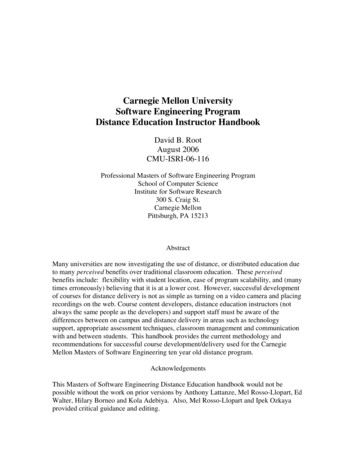
Transcription
Carnegie Mellon UniversitySoftware Engineering ProgramDistance Education Instructor HandbookDavid B. RootAugust 2006CMU-ISRI-06-116Professional Masters of Software Engineering ProgramSchool of Computer ScienceInstitute for Software Research300 S. Craig St.Carnegie MellonPittsburgh, PA 15213AbstractMany universities are now investigating the use of distance, or distributed education dueto many perceived benefits over traditional classroom education. These perceivedbenefits include: flexibility with student location, ease of program scalability, and (manytimes erroneously) believing that it is at a lower cost. However, successful developmentof courses for distance delivery is not as simple as turning on a video camera and placingrecordings on the web. Course content developers, distance education instructors (notalways the same people as the developers) and support staff must be aware of thedifferences between on campus and distance delivery in areas such as technologysupport, appropriate assessment techniques, classroom management and communicationwith and between students. This handbook provides the current methodology andrecommendations for successful course development/delivery used for the CarnegieMellon Masters of Software Engineering ten year old distance program.AcknowledgementsThis Masters of Software Engineering Distance Education handbook would not bepossible without the work on prior versions by Anthony Lattanze, Mel Rosso-Llopart, EdWalter, Hilary Borneo and Kola Adebiya. Also, Mel Rosso-Llopart and Ipek Ozkayaprovided critical guidance and editing.
Document RevisionsRevisionNumberDate1.0Affected 6/15/200408/08/2006AllAllAuthorAnthony LattanzeMichael CarrigerMel Rosso-LlopartEdward WalterHilary BorneoKola AdebiyiDavid RootDavid RootKeywords: Distance education, distributed education, course content development,course capture, distance instructor, software engineering2
TABLE OF CONTENTS1. INTRODUCTION . 51.11.21.31.4PURPOSE . 5MISSION . 5PROGRAM OVERVIEW . 5ASSUMPTIONS . 42. CURRENT TECHNOLOGIES. 62.1 SYNCHRONOUS TECHNOLOGIES . 62.2 ASYNCHRONOUS TECHNOLOGIES . 73. PROGRAM ROLES AND RESPONSIBILITIES. 83.1 OVERVIEW OF INDIVIDUAL ROLES . 83.2 CONTENT DEVELOPER – ROLES AND RESPONSIBILITIES . 93.3 SUPPORT STAFF – ROLES AND RESPONSIBILITIES . 153.4 DE INSTRUCTOR – ROLES AND RESPONSIBILITIES . 163.4.1 KEY LEARNING FACTORS FOR SUCCESSFUL DELIVERY . 173.4.2 OTHER RESPONSIBILITIES . 203.4.3 TEACHING PRACTICE IN DE. 204. STUDENT ROLES. 214.1 CORPORATE SPONSORED STUDENTS. 214.2 INDEPENDENT STUDENTS. 215. APPENDIX 1 MSE OVERVIEW AND HISTORY . . 223
4
1. Introduction1.1 PurposeThis handbook provides guidance, insight, and helpful hints for Course ContentDevelopers, Distance Education (DE) Instructors and Support Personnel involved in DEfor the Professional Masters of Software Engineering (MSE) program at Carnegie MellonUniversity (CMU).1.2 MissionThe mission of MSE Distance Education is to provide the same high quality program asthe on campus versions. While on campus students may take MSE-DE (Masters ofSoftware Engineering – Distance Education) courses with approval of their advisors, theprogram is targeted at full time working professionals who will take courses in their sparetime. Accordingly the largest value that DE provides is in its flexibility for delivery.1.3 Program OverviewThe MSE-DE program is a professional education program offered by Carnegie MellonUniversity since 1996. Students can participate in the MSE-DE program in one of fourways. Students can take:1. Individual MSE-DE courses for or without credit (if taken not for credit there willbe no official transcript generated by CMU).2. MSE-DE courses for credit towards a Certificate in Software Engineering (CSE)3. MSE-DE courses toward an MSIT-SE Degree (Master of Sciences in InformationTechnology – Software Engineering emphasis)4. SE-DE courses toward an MSE Degree (Master of Software Engineering).A more complete overview and history is in Appendix 1.1.4 AssumptionsThe success of the MSE-DE program is in part contingent on the continual camaraderiebetween the Course Content Developers, Distance Instructors, Support Personnel, and thequality of students accepted in the program. In general, the assumptions about thesegroups in the program are that they: Maintain the smooth and timely flow of information between stakeholders5
Work to resolved all issues regarding technology changes and methodologies in atimely mannerUnderstand the benefits and constraints of new technology in the delivery ofcourse materialsEvaluate and learn technology (hardware and software) needed in the delivery ofcourse materialsUnderstand the mission and strategies employed to ensure increased quality ineducational outcomesAll students accepted to the MSE-DE program regardless of whether for CSE,MSIT or MSE go through the same review process. It is assumed that studentsaccepted into on of these programs have met established criteria ensuring theirability to complete the program.2. Current Communication TechnologiesVarious technologies are currently available for use in the MSE-DE program. Thesetechnologies fall into two major categories. Synchronous technologies utilize real time communication methods betweenparties. This may include student – instructor interaction or student – studentinteraction. Asynchronous technologies also play a significant role in the how the MSE-DEcurriculum is designed. These technologies allow students to interact with coursematerials at their leisure, without demanding the immediate attention of aninstructor.The current state of technology available is constantly changing, improving, and must beevaluated by all associated with the MSE-DE program. Additionally, different courseswill have different technology needs. Course Content Developers should contact theMSE-DE, or Associate Director of DE to ascertain what is currently available to supporttheir courses.2.1 Synchronous TechnologiesSynchronous technologies enable instant, real time communication between participants.With synchronous technologies, students get more of a sense that they’re communicatingwith a person than they do with asynchronous mediums. This makes synchronousactivities and technologies valuable for team building and group collaboration. Pleasenote that the size of a DE group within a class, or the whole class itself involved insynchronous communication is a critical element that needs to be managed. The MSEDE program has found that groups should not exceed 10-12 people. Optimum sizeappears to be around five to eight participants, and that a group, (or whole class involved6
in a synchronous discussion) of 10-12 will normally result in only five to eight studentsparticipating each chatroom session. However, Course Content Developers and DEinstructors will need to reevaluate this for each class. In general, these are thesynchronous technologies used in the MSE-DE program: Conference calls are used when network constraints such as bandwidth orfirewalls restrict the use of computer based synchronous technologies.Online chat using discussion boards like BlackBoardTMs’ virtual classroom is apopular way for students and instructors to communicate synchronously. One ofthe advantages of a server based chat medium is that it can archive discussions forlater reference or review.Instant messaging is a very popular method for synchronous collaboration. Thefact that it is informal and easy to use makes it a popular choice for student –student communication. Some of the newer IM software also permits largergroups of participants as many as five with some clients. This makes it veryeasy to have ad hoc meetings without requiring server resources.Video conferencing provides a way for instructors who may not want theirmaterials captured permanently to present course content to remote students.Voice, video, desktop sharing over IP. This is new in 2005 and is still evolving.These provide synchronous communication and many allow simultaneous use ofvoice, video, “chats” and sharing of computer desktop environments. Many alsoallow recording of sessionsPod Casting. As of 2006 this is new and will require further study on its effectiveuse in promoting DE.All DE instructors should communicate with the Director or Associate Director of DE forthe MSE program on what technologies are currently being used. Course ContentDevelopers also need to be aware of what the currently technology is as it will impacthow they prepare their course for distance delivery. The Technical Advisor for DistanceDelivery (TADD) will be the key advisor on this during any course capture.2.2 Asynchronous TechnologiesAsynchronous technologies play a critical role in the MSE-DE program. Most if not allMSE DE classes have a large volume of asynchronous materials. These materials areused in tandem with other asynchronous communication technologies to provide the corecomponents of a DE course. Below is a brief summary of these technologies: Video & course capture is used to transmit individual lectures to remote students.This permits students to view a lecture at their convenience. Another advantageof this format is that it allows students to play back sections of a lecture that theymay not have understood initially. This can be very beneficial for foreignstudents for whom English is a second language. Well designed capture7
technologies also allow students to access portions of a lecture in a random accessfashion rather than serially. This gives captured courses additional functionalityas reference materials.Asynchronous discussion boards have been used by the MSE-DE program forseveral years. They provide a good method for temporally separated individualsto communicate regarding course materials and assignments. It has provendifficult, historically, to coordinate synchronous activities with participants inwidely varying time zones. BlackBoardTM offers discussion boards as part of itssoftware suite. The fact that BlackBoardTM has been adopted throughout theuniversity means that the effort involved in setting up and supporting one of theseboards is very small.Assignments and assessments are typically completed asynchronously. Theymust be designed so that they can be completed using the resources available to aDE student. Certain types of online surveys and tests may prove problematic forstudents without a reliable or inexpensive internet connectionReading materials are the standard asynchronous tool used in DE course delivery.Any materials required for completion of the course must be available to remotestudents. This means that requiring students to access resources from the campuslibrary may be inappropriate, such as a book put on “hold” for the course.However, while the library can’t put a whole book online under what is called an“electronic hold” they can scan specific chapters or sections and have thoseavailable online.3. Program roles and Responsibilities3.1 Overview of Individual rolesThe successful delivery of the Software Engineering DE program is contingent on thecooperation of the faculty and staff who develop and support the DE program. There arethree major roles which must be addressed in assembling a DE course unit: Course Content Developer: The course content developers are responsible fordetermining what material the course will cover. They must also provideappropriate materials to insure that the instructional goals of the course are beingmet. Finally, the content developer needs to design and structure the course sothat it can be successfully completed by students who are learning at a distance.The course content developer also owns the intellectual property of the course. Technical Advisor for Distance Delivery (TADD): This individual will beassigned by the MSE Distance Director, or Associate Distance Director. They8
will be familiar with MSE course capture and distance delivery methods, andhence will typically be a member of the MSE core faculty. They will advise thecourse developer on:o Development of the course with regards to its appropriateness for distancecapture and delivery.o Capture of the course, typically sitting in on all classes during the firsttaping of the course.o Development of the course’s instructor handbookThey will also be involved with the first distance offering of the course. Video Teaching Assistant: This could be the classes regular TA. Differentthough than a regular TA the Video TA will compile samples of annotated gradedassignments for inclusion in the course Rubric. They will also assist in editing thecaptured lectures. This role may also be assumed by the TADD. Support Personnel: The support personnel are responsible for capturing andpackaging the materials created by the course content developer so that they maybe presented at a distance. Typically, the team of support personnel includesvideo technicians and courseware specialists. DE Instructors: De instructors are sourced from core and adjunct faculty. Mostadjunct DE instructors are alumni of the program. The DE instructor’s primaryrole is to help the students work through and understand the materials that havebeen created by the course content developer. Each time a class is presented, aDE instructor is assigned to work with the class. The DE instructor will collectand grade assignments, answer questions regarding the course materials, andverify that the DE materials are accessible to the students participating in theclass.3.2 Content Developer – Roles and ResponsibilitiesA course content developers responsibilities may be divided into two major functionalareas. The first is the actual design of the course itself. The second area of responsibilityis ensuring the quality of the DE materials themselves with regards to lectures, transcriptsand written materials that support the course.Designing an effective DE course requires that the course author completes these tasks:Before production begins:9
Define the course’s requirements and goals. It’s difficult, if not impossible, todetermine whether a course is successful without knowing what it is attempting toachieve. Courses must be designed with distance education in mind. Anderson andGarrison in 1995 [AG] identified three major interconnected nodes that must be keptin mind: Student, Content and Instructor:Figure 1. Modes of Interaction in Distance Education from Anderson and Garrison, 1995 Define course constraints. These may include:o Access to certain material or software that is readily available on campus, butmay not be off campus. For instance using readings from books available atthe school libraries, but not readily available elsewhere without a largepurchase price, may hinder your class’s ability to be done at a distance.o Minimum number of students. Some classes need a minimum number ofstudents in order to “piece-work” the assignments, such as required bookreports, reviews, or to do group project work.o Maximum number of students. This may be important when considering thework load for a DE instructor that will be grading all of the assignments. TheMSE-DE target is for 5-8 hours per week of work for any DE instructor. Thisincludes all chatrooms, answering emails/phone calls and grading homework.10
Assessment methods, assignments, homework. All should be appropriate for the goalsof the course and in class and distance use. Assessments should be designed to measuretwo different things. First, they need to determine whether students are successfullylearning the material being covered. Next they need to provide feedback which allowsthe instructor to determine how the DE format is affecting learning.o Tests work well for both on campus and distance students. Ensure that the testtaking time limit is included with the test. Due to the constraints of DE teststhat are “take home” work better than in class type as the DE instructor willtypically have no control over the environment that the DE student is in whiletaking the test.o Presentations. These are very hard to do online where the DE students arescattered about different time zones. However, they are still possible usingcertain technologies that allow desktop, voice and even video to a group.Asynchronous communication may work better, such as a threaded discussionboard. This works on campus and DE. For instance, the presenter starts thethread, and then is required to answer all questions posed by the DE instructorand other students. Also, the other students are required to comment on theinitial thread and one or more other student comments.o In class exercises may also be difficult to do in a DE setting, however thisisn’t impossible. The use of PC desktop sharing along with Voice over IP hasallowed this to be effectively done in distance classes.o Coupling with MSE studio projects. Remember that the distance students willtypically not be able to work with a studio project team, so if required anacademic project will have to be set up. One method for this is to use a pastproject. However, if this is done the developer may have to request limitedaccess to that projects website to prevent DE students from copying pastdeveloped material instead of learning by developing it on their own. Also, itmay be simpler to just de-couple the course from studio as the majority of DEstudents are MSIT-SE that do not have to do a studio project.Review the available content delivery methods and technologies.One of the best indicators for success in DE is the level of interaction students areengaged in while taking the course. Choose presentation technologies which will engagethe students without distracting them from the course itself. One such technology is WebArrowTM. This allows chat, VOIP and the sharing of PC desktops so all can see what aspecific participant is doing.Select supplemental materials which are appropriate for distance learning.The Technology
The MSE-DE program is a professional education program offered by Carnegie Mellon University since 1996. Students can participate in the MSE-DE program in one of four ways. Students can take: 1. Individual MSE-DE courses for or without credit (if taken not for credit there will be no official transcript generated by CMU). 2.
